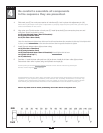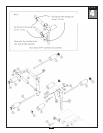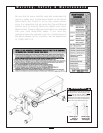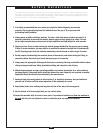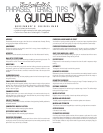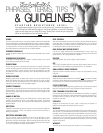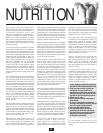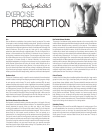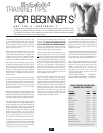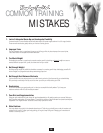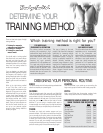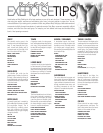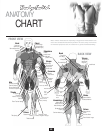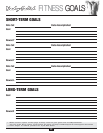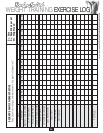
TRAINING TIPS
FOR BEGINNER’S
As a beginner, one of the most common mistakes is doing
too much. Because beginners often make good gains
quickly, many fall into the trap of thinking that more is better.
This may be true later in the training equation, but not for the
novice. Some of the most common injuries occur as a result
of taking on too much, too soon.
One of the questions most frequently asked is, “How much
weight should I use?” Determining the weight for each
exercise will vary from person to person. The weight for each
exercise will be lifted in sets and repetitions. Repetition
is defined as one execution of any exercise. A set is a
combination of any number of repetitions of one exercise.
Experimentation at each exercise station is a good technique
for determining the starting weight for an individual. Take the
chest press exercise for example. Performing this exercise
with a weight that can be pressed 30 times with ease will
not help you achieve any particular goals. Adding the
appropriate amount of weight that will allow you to perform
a maximum of 8 to 12 repetitions will help you obtain the
results you desire.
On the other hand, if you put too much weight on the press
bar and press it 4 or 5 times, then common sense will tell
you to reduce the weight, wait a few minutes, then try again.
Remember, never sacrifice perfect form just for the sake of
lifting heavier weight. This is a sure-fire, one-way trip down
the road to injury. Making muscles work hard, with proper
form is the name of the game.
Now that you understand how to test each station for your
starting amount of resistance, you should know which muscles
to train first. Training the large muscles groups first, such as your
chest, legs, and back, should be done before training your
small muscle groups like the arms, shoulders, and calves.
Starting with the large muscle groups will help you achieve
and maintain quicker gains. The large muscles groups will
require more stimulation and a higher intensity level than the
smaller muscle groups. Training your arms with all-out
intensity and training your chest immediately afterwards will
not leave you with enough energy necessary to properly
stimulate the muscle fibers in your chest. Moreover,
because the triceps are required in chest press movements,
your arm muscles will fail much more quickly than your
chest muscles, which will also hold back your chest training.
As a beginner, you will find that your gains will come quickly.
The excitement and enthusiasm that comes with these gains
may cause you to spend even more time on your gym. Take
it easy! Remember, just as too little exercise won’t stimulate
muscle growth...too much exercise won’t either.
You need to give your body plenty of rest, especially if you’re
still sore from the last workout. This will keep you fresh and
growing stronger.
NEVER TRAIN A BODY PART THAT
IS STILL SORE FROM THE PREVIOUS WORKOUT.
Performing some flexibility exercises is a good way to keep
the blood flowing through the sore area, but do not train
these muscles again until you are feeling recovered.
Speaking of soreness, there is something else that you, as a
beginner, should be aware of: If you work out - your muscles
will
get sore. The majority of muscle soreness comes from
microtears and a build up of lactic acid in the muscle fibers.
This is the result of intense exercise. Muscle soreness can
become a problem when the body is pushed too fast and
too quickly. As a beginner, tendons, ligaments, joints and
tissues have not yet developed the ability necessary to
recover from high intensity exercise. A general warm up of
stretching and light calisthenics prior to exercise can
possibly reduce the amount of post-exercise muscle
soreness. A good cool down of stretching and cardio work
may also decrease muscle soreness.
Now that we have laid a good foundation of the “do’s and
don’ts”, let’s get into something a little more specific.
The Beginner’s Strength Training Program. One of the best
beginner’s programs is the three-days-a-week routine. For
example, do a whole-body workout on Monday, Wednesday
and Friday. Use the other days for rest and recuperation. As
previously discussed, you want to start with the large
muscle groups first, then move on to the small muscle
groups. Perform one exercise per muscle group that
consists of 2 or 3 sets of 8 to 12 repetitions. Follow this
routine for at least six to eight weeks in order for your body
to establish the proper stimulation for growth.
One or two exercises per muscle group may not sound like
enough to produce any results, but if you’re a beginer - it
most definitelty will. As you conitinue to train and your body
adapts to your exercise routine and recuperative demands
you place upon it, you’ll be able to add more sets and
exercises to your routine.
Another point that is highly recommended is the assistance
of a personal trainer. Through the use of a personal trainer
you can learn the mechanics and techniques of exercise, how
to use proper form to avoid injury and details on proper
nutrition. A good trainer will also provide MOTIVATION.
When choosing a personal trainer, here are some tips:
Choose an individual that is certified through an accredited
association. This is a good way to ensure that he or she is
qualified to give you what you need. Also, take a look
at what kind of shape they are in. If you want to be in
great shape, look for a trainer who is in great shape.
They will know what it takes to get results. Here are a few
recommended organizations:
• National Strength & Conditioning (719) 632-6722
• American College of Sports Medicine (317) 637-9200
• National Academy of Sports Medicine (312) 929-5101
SAMPLE WORKOUT ROUTINE WHEN
TRAINING FOR STRENGTH
Exercises
Reps Sets
Leg Press / Squat 8 to 12 2 or 3
Leg Extension 8 to 12 2 or 3
Leg Curl 8 to 12 2 or 3
Calf Raise 8 to 12 2 or 3
Bench / Chest Press 8 to 12 2 or 3
Incline Press 8 to 12 2 or 3
Incline Pec Fly 8 to 12 2 or 3
Lat Pulldown 8 to 12 2 or 3
Seated Row 8 to 12 2 or 3
Military Press 8 to 12 2 or 3
Upright Row 8 to 12 2 or 3
Bicep Curl 8 to 12 2 or 3
Tricep Pressdown 8 to 12 2 or 3
Tricep Extension 8 to 12 2 or 3
Resistance Ab Crunch 20 to 30 2 or 3
Resistance Oblique Crunch 20 to 30 2 or 3
Rest period between sets should be about 60 to 90 seconds.
ARE YOU A “BEGINNER”?
A beginner can be classified as someone who has never touched a weight, may have lifted for a while,
but has taken a substantial amount of time off, or has not consistently trained over the last six months.
If you happen to fall into any of these categories, pay close attention, because the following information
will be detrimental to the start of your training program.
17



